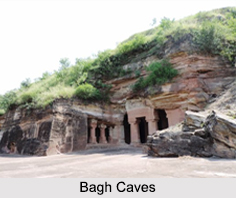 Bagh caves of Madhya Pradesh are reckoned amongst the finest specimens of Buddhist art and architecture in India. These are famous for mural paintings done by master painters of ancient India. Bagh Caves are one of the best examples of Buddhist culture in western Madhya Pradesh of Central India. Out of the original 9 caves only 5 have been in existence currently.
Bagh caves of Madhya Pradesh are reckoned amongst the finest specimens of Buddhist art and architecture in India. These are famous for mural paintings done by master painters of ancient India. Bagh Caves are one of the best examples of Buddhist culture in western Madhya Pradesh of Central India. Out of the original 9 caves only 5 have been in existence currently.
Etymology of Bagh Caves
It is believed that Bagh caves got this name from Hindi language in which "Bagh" means Tiger and "Gufa" means Caves. Due to presence of water through river and presence of enough prey in forest area these caves became an ideal shelter for tigers. Due to presence of tigers, it got its name Bagh Caves.
History of Bagh Caves
There are around 36 epigraphs covering the period from 358 to 487 AD. Study illustrates that throughout that period it was ruled by the Guptas. It is said that the Bagh Caves were first brought in to light by Lieutenant Dangerfield who published his conclusion in the Transactions of the Literary Society of Bambay Vol. II in 1818. Later it was tripped by Dr. E. Impey in the year 1854 who published a comprehensive description of Bagh Caves in 1856 in the journal of the Bombay Branch of the Royal Asiatic Society Vol. Archaeological Survey of India carried the foremost conservation work in the year 1981 and saved its five caves which can be visited nowadays. In the following year 1982, a bridge was constructed for making the access easier for visitors. It is believed that the Buddhist hermits once resided here and used the place as their meditation centre and for religious congregations.
Location of Bagh Caves
The caves are situated 50 km west of Mandu on the road between Indore and Vadodara. The caves are situated 6 kilometers from the village of Bagh and are 97 kilometers away from the town of Dhar District.
Art and Architecture of Bagh Caves
Bagh Caves resemble the architectural patterns of the Ajanta Caves. They have been constructed on a perpendicular rock face of the Vindhya Range near the bank of River Bahini. There are nine caves at Bagh Caves of which five have survived till date. The most magnificent of them is Cave No. 4, the Rang Mahal. In 1982 the caves were reconstructed and the paintings inside were carefully removed and replaced into nearby Archaeological Museum of Gwalior State.
The Bagh caves have impressions of Buddhist inscriptions. The most famous features of Bagh Caves are murals made in tempera technique. Inside the cave there are residential units and a main cell used as a prayer hall with the stupa of Lord Buddha cantering the room. Numerous sculptures of Buddha and Boddhisattvas have been constructed inside the cave. Even the walls and ceilings of the `viharas` of Bagh are decorated beautifully with paintings which have a strong resemblance with the Ajanta paintings. A painting of the Bodhisattva `Padmapani`, housed here, illustrates the Padmapani figure found in Ajanta. Outside the caves stands a colossal image of Yaksharaj. The ancient murals and frescos embossed on the walls, porticos and ceilings are considered as masterpieces of the artisans of that period. Among the nine caves, Cave 2 named as Pandav cave is the largest and structurally the best preserved one. The hall of the cave has 24 enormous pillars with copper plates bearing the inscriptions about donations by Maharaja Subandhu in late 5th century AD. Cave 3 named Hathyakana holds the remnants of murals. Cave 4, called the Rang Mahal (Palace of Colors) is the magnificent of them all. It has the best murals on the walls of portico. Cave 5 earlier served as a conference room for Buddhist monks. This cave was later conjoined with the Cave 6. Rest of the other caves are mostly collapsed and under construction work.
Visiting information of Bagh Caves
Dhar is 64 kilometers far from Indore and caves are 97 kilometers from Dhar. The nearest airport and railway station is Indore, which are approx 160 kilometers from the Bagh Caves. One can hire private buses or hire Taxis from Indore for Dhar to reach Bagh cave.



















